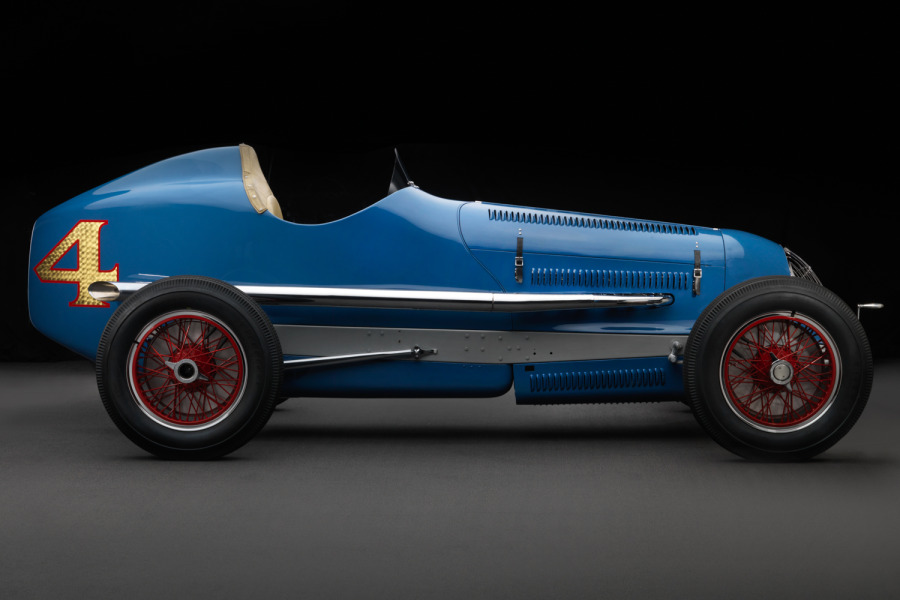1930 Duesenberg Fred Frame Sprint Car

The descriptions of the Classic Cars in the Directory were partly generated or supplemented with the help of artificial intelligence (AI). The content may occasionally not always be entirely accurate or factually correct despite careful checking.
The Duesenberg Fred Frame Sprint car 1930 is a monumental piece of engineering excellence born from a collaborative effort between the Duesenberg brothers and the legendary racing driver Fred Frame. This exceptional Sprint car was handcrafted in the 1930s and designed to be one of the most powerful and advanced race cars of its era.
The car boasts a lightweight yet sturdy chassis, constructed entirely of steel tubing, which provides both exceptional rigidity and excellent weight distribution. The front suspension of the car employs a typical solid axle design, complemented by custom-made extensions that act as extra shock absorbers. The rear employs a unique design, featuring a triangulated live-axle setup with custom-made radius rods and unique axle links, allowing for enhanced stability and unmatched handling precision.
Under the hood, the car is fitted with a naturally aspirated DOHC 4-valve-per-cylinder mill, with an air displacement capacity of 5.5 liters that pumps out an impressive 200 horsepower. Power delivery is made to the rear wheels via a 3-speed manual transmission, featuring a lightweight flywheel and a custom-built shift linkage for quick and precise shifts.
The car's bodywork is an intricate blend of aerodynamic curves and classic styling that was designed to reduce wind resistance and improve cornering capabilities while still remaining faithful to the car's period-correct design. The frame has been wrapped in handmade aluminum panels that are complemented by the car's signature paint scheme, consisting of metallic silver and orange, with Duesenberg's iconic lettering on the hood.
The cockpit of the car is a minimalist affair, featuring a lightweight race seat, a custom-built steering wheel wrapped in soft leather, and a steel instrument panel fitted with custom gauges that keep tabs on the car's vitals. The driver's seat is positioned low in the car, offering excellent visibility, and the steering wheel is positioned at just the right angle for precise and effortless control.
The brakes on the Duesenberg Fred Frame Sprint car 1930 are customized hydraulic drums. The front and back wheels have different sizes of brake drums to manage the braking potential efficiently. The brake shoes are adjustable as well to accommodate different driving conditions.
In a nutshell, the Duesenberg Fred Frame Sprint car 1930 is an exceptional, meticulously crafted piece of automotive engineering that is a true testament to the era's racing pedigree. Its timeless design and advanced technology allowed it to stand out, capturing the hearts of car enthusiasts worldwide, and creating a lasting legacy in the racing world that still endures to this day.
Milestones
- In 1930, Duesenberg introduced the Fred Frame Sprint car, specifically designed for dirt track racing. - The car was powered by a 255 cubic inch inline-8 engine, producing around 170 horsepower. - It featured a lightweight frame made of chrome-moly steel, allowing for better handling and speed on dirt tracks. - The Fred Frame Sprint car was known for its distinctive appearance, with an exposed radiator and a large external exhaust pipe. - The car quickly became a dominant force in sprint car racing, winning numerous races and championships throughout the 1930s. - Notable drivers of the Duesenberg Fred Frame Sprint car included Bill Cummings, Mel Kenealy, and Cliff Bergere. - The car's success helped establish Duesenberg as one of the top racing car manufacturers of the era, alongside companies like Miller and Offenhauser. - Despite its success, the Fred Frame Sprint car was only produced for a few years before Duesenberg shifted its focus to other types of race cars.Technical
• Model year: 1930 • Manufacturer: Duesenberg Motors • Car type: Fred Frame Sprint Car • Engine type: DOHC straight eight-cylinder • Engine size: 420 cubic inches • Horsepower: 265 • Transmission: Three-speed manual • Wheelbase: 116 inches • Suspension: Front and rear semi-elliptic leaf springs with Andre Hartford friction shocks • Brakes: Front and rear hydraulic drum • Tires: Front 5.00-19 and rear 7.50-19 • Top speed: Approximately 130 mph • Number of built: Only 5 prototype cars were built • Historical significance: Duesenberg sprint cars were dominant performers in their day and represented the pinnacle of American racing engineering. Fred Frame, the driver for whom this model was named, won the prestigious "Little 500" race in Indiana in 1932 in a Duesenberg-powered car.